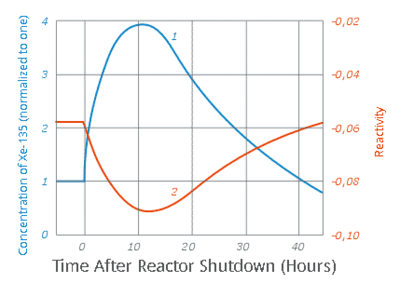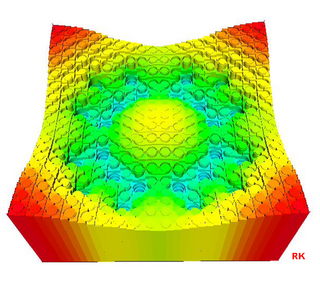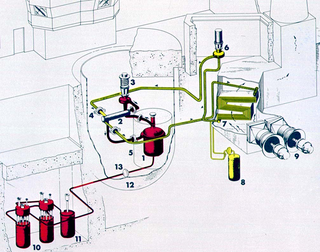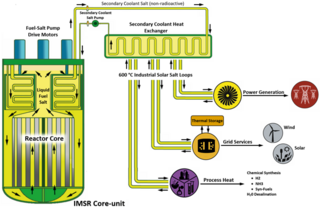Fission products decay and burnup
One of the common fission products is 135Te, which undergoes beta decay with half-life of 19 seconds to 135I. 135I itself is a weak neutron absorber. It builds up in the reactor in the rate proportional to the rate of fission, which is proportional to the reactor thermal power. 135I undergoes beta decay with half-life of 6.57 hours to 135Xe. The yield of 135Xe for uranium fission is 6.3%; about 95% of 135Xe originates from decay of 135I.
135Xe is the most powerful known neutron absorber, with a cross section for thermal neutrons of 2.6×106 barns, [1] so it acts as a "poison" that can slow or stop the chain reaction after a period of operation. This was discovered in the earliest nuclear reactors built by the Manhattan Project for plutonium production. As a result, the designers made provisions in the design to increase the reactor's reactivity (the number of neutrons per fission that go on to fission other atoms of nuclear fuel). [2] 135Xe reactor poisoning played a major role in the Chernobyl disaster. [3]
By neutron capture, 135Xe is transformed ("burned") to 136Xe, which is effectively [lower-alpha 1] stable and does not significantly absorb neutrons.
The burn rate is proportional to the neutron flux, which is proportional to the reactor power; a reactor running at twice the power will have twice the xenon burn rate. The production rate is also proportional to reactor power, but due to the half-life time of 135I, this rate depends on the average power over the past several hours.
As a result, a reactor operating at constant power has a fixed steady-state equilibrium concentration, but when lowering reactor power, the 135Xe concentration can increase enough to effectively shut down the reactor. Without enough neutrons to offset their absorption by 135Xe, nor to burn the built-up xenon, the reactor has to be kept in shutdown state for 1–2 days until enough of the 135Xe decays.
135Xe beta-decays with half-life of 9.2 hours to 135Cs; a poisoned core will spontaneously recover after several half-lives. After about 3 days of shutdown, the core can be assumed to be free of 135Xe, without it introducing errors into the reactivity calculations. [4]
The inability of the reactor to be restarted in such state is called xenon precluded start up or dropping into an iodine pit; the duration of this situation is known as xenon dead time, poison outage, or iodine pit depth. Due to the risk of such situations, in the early Soviet nuclear industry, many servicing operations were performed on running reactors, as downtimes longer than an hour led to xenon buildup that could keep the reactor offline for significant time, lower the production of 239Pu, required for nuclear weapons, and would lead to investigations and punishment of the reactor operators. [5]
Xenon-135 oscillations
The interdependence of 135Xe buildup and the neutron flux can lead to periodic power fluctuations. In large reactors, with little neutron flux coupling between their regions, flux nonuniformities can lead to formation of xenon oscillations, periodic local variations of reactor power moving through the core with a period of about 15 hours. A local variation of neutron flux causes increased burnup of 135Xe and production of 135I, depletion of 135Xe increases the reactivity in the core region. The local power density can change by a factor of three or more, while the average power of the reactor stays more or less unchanged. Strong negative temperature coefficient of reactivity causes damping of these oscillations, and is a desired reactor design feature. [4]
Iodine pit behavior

The reactivity of the reactor after the shutdown first decreases, then increases again, having a shape of a pit; this gave the "iodine pit" its name. The degree of poisoning, and the depth of the pit and the corresponding duration of the outage, depends on the neutron flux before the shutdown. Iodine pit behavior is not observed in reactors with neutron flux density below 5×1016 neutrons m−2s−1, as the 135Xe is primarily removed by decay instead of neutron capture. As the core reactivity reserve is usually limited to 10% of Dk/k, thermal power reactors tend to use neutron flux at most about 5×1013 neutrons m−2s−1 to avoid restart problems after shutdown. [4]
The concentration changes of 135Xe in the reactor core after its shutdown is determined by the short-term power history of the reactor (which determines the initial concentrations of 135I and 135Xe), and then by the half-life differences of the isotopes governing the rates of its production and removal; if the activity of 135I is higher than activity of 135Xe, the concentration of 135Xe will rise, and vice versa.
During reactor operation at a given power level, a secular equilibrium is established within 40–50 hours, when the production rate of iodine-135, its decay to xenon-135, and its burning to xenon-136 and decay to caesium-135 are keeping the xenon-135 amount in the reactor constant at a given power level.
The equilibrium concentration of 135I is proportional to the neutron flux φ. The equilibrium concentration of 135Xe, however, depends very little on neutron flux for φ > 1017 neutrons m−2s−1.
Increase of the reactor power, and the increase of neutron flux, causes a rise in production of 135I and consumption of 135Xe. At first, the concentration of xenon decreases, then slowly increases again to a new equilibrium level as now excess 135I decays. During typical power increases from 50 to 100%, the 135Xe concentration falls for about 3 hours. [6]
Decrease of the reactor power lowers production of new 135I, but also lowers the burn rate of 135Xe. For a while 135Xe builds up, governed by the amount of available 135I, then its concentration decreases again to an equilibrium for the given reactor power level. The peak concentration of 135Xe occurs after about 11.1 hours after power decrease, and the equilibrium is reached after about 50 hours. A total shutdown of the reactor is an extreme case of power decrease. [7]











